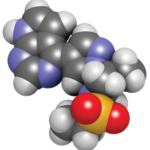In the Scottish Early RA Collaboration, researchers have tried to recruit every new case of rheumatoid arthritis. The cohort now includes 1,200 people. One part of this project—the Scottish Nested Arthritis Progression Study (SNAP)—involves detailed immunological phenotyping of patients as they progress through their first year with the disease.
Peripheral blood samples are analyzed ex vivo and then are stimulated with a “cytokine cocktail.” Researchers are looking for clues that will give them an idea of who will respond and of the nature of the response to a given therapeutic. Some of this work has focused on the JAK-STAT pathway.
The data are not yet published, but researchers have measured levels of phosphorylated STAT (pSTAT) proteins and found that higher levels of some pSTATs at baseline across distinct cell subsets seem to be a sign that someone will respond to methotrexate, Dr. McInnes said.
“It’s actually very much a STAT signal, which is telling us about the capacity of somebody to respond to methotrexate,” he said. “There are detectable signals in circulating peripheral blood of people with rheumatoid arthritis with early disease.”
As the search continues for new RA therapies, personalization will loom large, he said. And because JAK-inhibitors can target multiple cytokine receptors at the same time, they will have the capacity to play a big part in this process.
‘If [a therapy is] so clean & so selective that it is ineffective, then it is not a particularly good therapy. Toxicity can be managed. Lack of efficacy cannot.’ —Dr. Firestein
“New medicines that we are going to make in rheumatology, particularly rheumatoid, are only going to fly if they actually deliver real added value,” Dr. McInnes said. “Because their [JAK-inhibitors’] targets are discernible, they are really very interesting targets for the personalization of therapeutics.”
Effects on Cartilage & Bone Damage
A challenge going forward in the development of kinase inhibitors is determining their effects on cartilage and bone damage, said Florian Meier, MD, a clinical research fellow in rheumatology and clinical immunology at the University of Giessen.
Data on radiographic progression from clinical trials so far have been limited, and what have been collected have, for the most part, not been evaluated or shared yet, he said. Results from animal studies don’t necessarily predict results in humans, Dr. Meier said.
“Phase 2 clinical trial program(s),” he said, “should include data on radiographic progression.”
Thomas R. Collins is a freelance medical writer based in Florida.
References
- Taylor PC, Genovese MC, Greenwood M, et al. OSKIRA-4: A phase IIb randomised, placebo-controlled study of the efficacy and safety of fostamatinib monotherapy. Ann Rheum Dis. 2015 Dec;74(12):2123–2129.
- Genovese MC, Yang F, Ostergaard M, et al. Efficacy of VX-509 (decernotinib) in combination with a disease-modifying antirheumatic drug in patients with rheumatoid arthritis: Clinical and MRI findings. Ann Rheum Dis. 2016 Apr 15.
- Genovese MC, Kremer J, Zamani O, et al. Baricitinib in patients with refractory rheumatoid arthritis. N Engl J Med. 2016 Mar 31;374(13):1243–1252.

